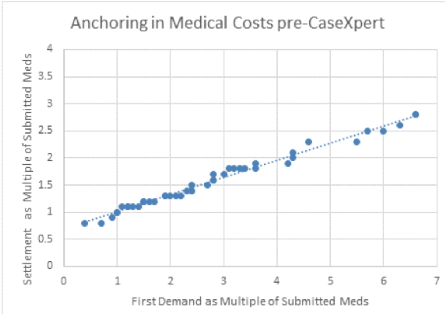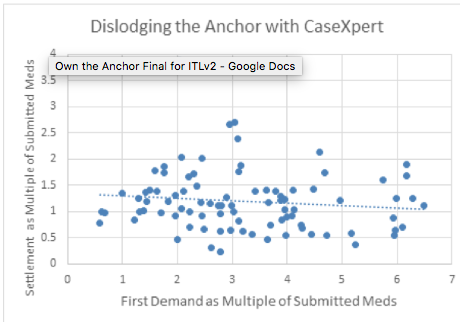Anchoring occurs in third-party settlement negotiations when one side throws out a number in an effort to influence—or “anchor”—the way the opposing party values a claim. Our experience shows that anchoring directly affects the settlement value of injury claims, so it’s critically important for insurance adjusters to “own the anchor” in negotiations.
What Drives Anchoring?
Anchors come in many varieties, but we find that medical costs are, by far, the greatest and most troublesome. It’s natural to assume that medical costs are an important factor to a settlement and a possible starting point in a negotiation.
We are aware that some medical providers grossly overcharge for services and run up their bills. Most of us also know full well that medical costs are only one factor to consider and shouldn’t be the sole determinant of claim value.
However, what we don’t realize is that medical bills have an undetectable and powerful impact on the ultimate settlement amount. While we believe we treat medical costs as separate and distinct from other elements in a claim, our research demonstrates that medical costs have an oversized influence on the pain and suffering portion of the claim.
The Proof
Chart 1

To understand how medical costs influence, or anchor, the settlement, we looked at the relationship of first demands as a multiple of submitted medical costs (e.g., a settlement demand of $10,000 with $2,000 in submitted medical bills represents a 5:1 multiple), with final settlements as a multiple of medical costs (a $6,000 settlement demand with $2,000 in medical bills has a 3:1 ratio).
Chart 1 illustrates how medical costs dramatically affect the amount we are willing to settle for. It’d be hard to show any higher correlation. The higher the demand by a plaintiff attorney vis-à-vis the medical bills, the higher the settlement the attorney was able to negotiate. The plaintiff attorney very effectively “owns the anchor” by anchoring the overall value of the claim in the medical costs.
See also: Surprise Medical Bills: Just a Distraction
Why Medical Bills Influence
Medical bills have such an outsized impact on settlement values because they are, often, the only tangible item in discussions. Venue, pain and suffering, a claimant’s age, etc., aren’t tangible. By contrast, the dollar amounts shown in medical bills are easy to reference, and we naturally latch on to them.
Even when we seek to discredit the medical bills, we’re still referencing them, granting them relevance, even authority. They stubbornly remain the anchor.
The Fact-Based Fix
Chart 2

Thankfully, facts are stubborn, too, and work very effectively to unseat anchors!
Plaintiff attorneys rely heavily (and successfully) on medical costs that they fail to examine to understand the underlying facts of their case. To exploit a claim’s facts, the approach demands a command and use of the facts of the injury and its treatment.
As Chart 2 illustrates, the same adjusters who produced the results in Chart 1 were subsequently able to “own the anchor” through negotiation grounded in facts. Our experience shows that using fact-based analyses dislodges the anchor of the submitted medical bills. In fact, the bills showed a negative correlation on the ultimate settlement accepted by the plaintiff attorneys.
The dispersion of results in Chart 2 shows that the tight relationship between submitted medical bills and settlements had ceased, with the anchor effectively displaced. This yields accurate settlement values grounded in facts. When arguing from facts, the adjuster calls the plaintiff attorney’s medical bill bluff and “owns the anchor.”
Set Sail
It's facts or nothing.
So, how do we stake our negotiations in facts? The answer rests in shifting a case from its “raw data,” like medical bill costs, to substantive arguments. And we don't mean bill review services, which focus on explanations of benefits and reductions in charges according to a fee schedule. Their use of obscure medical codes and rules, which aren't widely understood or capably explained in negotiations, means that bill reviews diminish their authority and can't help us to unseat the anchor.
Substantive arguments must be backed by evidence drawn directly from claim records, such as information from treatment notes, emergency room reports and observations from the medical world about how injuries are objectively documented and what justified medical care looks like. This approach will lower your ultimate settlement costs, with the wind in your sails.
See also: How to Cut Litigation Costs for Claims
For example, in a soft tissue injury case, plaintiff lawyers frequently assert that their client struggles with everyday activities. Rather than being drawn into this assertion, adjusters must undertake a thorough review of the claimant’s medical records (including treating physician, chiropractor and physical therapist notes) to determine if evidence is presented that demonstrates actual physical impairment. This includes examining observations of the claimant’s range of motion, strength and other functional deficits. If we aren’t prepared with this information, it is not difficult for a plaintiff attorney to use these assertions in conjunction with anchoring to drive the doubt in one’s mind that drives up the offers we’re willing to make. Except to the extent the lawyer’s claim of severe injury can be tied directly to evidence in the medical records, there is no basis for the adjuster’s evaluation to be influenced by the lawyer’s assertion. Where objective medical data indicates little to no impairment, claims of daily distress don’t hold water.
To dislodge the anchor cast by a plaintiff’s lawyer, adjusters must have organized medical records, a methodology (including the use of medical standards) to consistently review and interrogate the evidence from those records and the ability to produce a single, coherent assessment of the claim. We have found that the most effective use of evidence lies in the assessment of each component of a claim–-the pain and suffering of each injury, the legitimacy of claimed medical costs from each healthcare provider, the support for lost time from work. This is carried into negotiation, where an adjuster methodically presents his or her analysis of the claim and uses tactics for focusing the claim on facts. Training is a necessary element in this, but the dividends are significant.
 To understand how medical costs influence, or anchor, the settlement, we looked at the relationship of first demands as a multiple of submitted medical costs (e.g., a settlement demand of $10,000 with $2,000 in submitted medical bills represents a 5:1 multiple), with final settlements as a multiple of medical costs (a $6,000 settlement demand with $2,000 in medical bills has a 3:1 ratio).
Chart 1 illustrates how medical costs dramatically affect the amount we are willing to settle for. It’d be hard to show any higher correlation. The higher the demand by a plaintiff attorney vis-à-vis the medical bills, the higher the settlement the attorney was able to negotiate. The plaintiff attorney very effectively “owns the anchor” by anchoring the overall value of the claim in the medical costs.
See also: Surprise Medical Bills: Just a Distraction
Why Medical Bills Influence
Medical bills have such an outsized impact on settlement values because they are, often, the only tangible item in discussions. Venue, pain and suffering, a claimant’s age, etc., aren’t tangible. By contrast, the dollar amounts shown in medical bills are easy to reference, and we naturally latch on to them.
Even when we seek to discredit the medical bills, we’re still referencing them, granting them relevance, even authority. They stubbornly remain the anchor.
The Fact-Based Fix
Chart 2
To understand how medical costs influence, or anchor, the settlement, we looked at the relationship of first demands as a multiple of submitted medical costs (e.g., a settlement demand of $10,000 with $2,000 in submitted medical bills represents a 5:1 multiple), with final settlements as a multiple of medical costs (a $6,000 settlement demand with $2,000 in medical bills has a 3:1 ratio).
Chart 1 illustrates how medical costs dramatically affect the amount we are willing to settle for. It’d be hard to show any higher correlation. The higher the demand by a plaintiff attorney vis-à-vis the medical bills, the higher the settlement the attorney was able to negotiate. The plaintiff attorney very effectively “owns the anchor” by anchoring the overall value of the claim in the medical costs.
See also: Surprise Medical Bills: Just a Distraction
Why Medical Bills Influence
Medical bills have such an outsized impact on settlement values because they are, often, the only tangible item in discussions. Venue, pain and suffering, a claimant’s age, etc., aren’t tangible. By contrast, the dollar amounts shown in medical bills are easy to reference, and we naturally latch on to them.
Even when we seek to discredit the medical bills, we’re still referencing them, granting them relevance, even authority. They stubbornly remain the anchor.
The Fact-Based Fix
Chart 2
 Thankfully, facts are stubborn, too, and work very effectively to unseat anchors!
Plaintiff attorneys rely heavily (and successfully) on medical costs that they fail to examine to understand the underlying facts of their case. To exploit a claim’s facts, the approach demands a command and use of the facts of the injury and its treatment.
As Chart 2 illustrates, the same adjusters who produced the results in Chart 1 were subsequently able to “own the anchor” through negotiation grounded in facts. Our experience shows that using fact-based analyses dislodges the anchor of the submitted medical bills. In fact, the bills showed a negative correlation on the ultimate settlement accepted by the plaintiff attorneys.
The dispersion of results in Chart 2 shows that the tight relationship between submitted medical bills and settlements had ceased, with the anchor effectively displaced. This yields accurate settlement values grounded in facts. When arguing from facts, the adjuster calls the plaintiff attorney’s medical bill bluff and “owns the anchor.”
Set Sail
It's facts or nothing.
So, how do we stake our negotiations in facts? The answer rests in shifting a case from its “raw data,” like medical bill costs, to substantive arguments. And we don't mean bill review services, which focus on explanations of benefits and reductions in charges according to a fee schedule. Their use of obscure medical codes and rules, which aren't widely understood or capably explained in negotiations, means that bill reviews diminish their authority and can't help us to unseat the anchor.
Substantive arguments must be backed by evidence drawn directly from claim records, such as information from treatment notes, emergency room reports and observations from the medical world about how injuries are objectively documented and what justified medical care looks like. This approach will lower your ultimate settlement costs, with the wind in your sails.
See also: How to Cut Litigation Costs for Claims
For example, in a soft tissue injury case, plaintiff lawyers frequently assert that their client struggles with everyday activities. Rather than being drawn into this assertion, adjusters must undertake a thorough review of the claimant’s medical records (including treating physician, chiropractor and physical therapist notes) to determine if evidence is presented that demonstrates actual physical impairment. This includes examining observations of the claimant’s range of motion, strength and other functional deficits. If we aren’t prepared with this information, it is not difficult for a plaintiff attorney to use these assertions in conjunction with anchoring to drive the doubt in one’s mind that drives up the offers we’re willing to make. Except to the extent the lawyer’s claim of severe injury can be tied directly to evidence in the medical records, there is no basis for the adjuster’s evaluation to be influenced by the lawyer’s assertion. Where objective medical data indicates little to no impairment, claims of daily distress don’t hold water.
To dislodge the anchor cast by a plaintiff’s lawyer, adjusters must have organized medical records, a methodology (including the use of medical standards) to consistently review and interrogate the evidence from those records and the ability to produce a single, coherent assessment of the claim. We have found that the most effective use of evidence lies in the assessment of each component of a claim–-the pain and suffering of each injury, the legitimacy of claimed medical costs from each healthcare provider, the support for lost time from work. This is carried into negotiation, where an adjuster methodically presents his or her analysis of the claim and uses tactics for focusing the claim on facts. Training is a necessary element in this, but the dividends are significant.
Thankfully, facts are stubborn, too, and work very effectively to unseat anchors!
Plaintiff attorneys rely heavily (and successfully) on medical costs that they fail to examine to understand the underlying facts of their case. To exploit a claim’s facts, the approach demands a command and use of the facts of the injury and its treatment.
As Chart 2 illustrates, the same adjusters who produced the results in Chart 1 were subsequently able to “own the anchor” through negotiation grounded in facts. Our experience shows that using fact-based analyses dislodges the anchor of the submitted medical bills. In fact, the bills showed a negative correlation on the ultimate settlement accepted by the plaintiff attorneys.
The dispersion of results in Chart 2 shows that the tight relationship between submitted medical bills and settlements had ceased, with the anchor effectively displaced. This yields accurate settlement values grounded in facts. When arguing from facts, the adjuster calls the plaintiff attorney’s medical bill bluff and “owns the anchor.”
Set Sail
It's facts or nothing.
So, how do we stake our negotiations in facts? The answer rests in shifting a case from its “raw data,” like medical bill costs, to substantive arguments. And we don't mean bill review services, which focus on explanations of benefits and reductions in charges according to a fee schedule. Their use of obscure medical codes and rules, which aren't widely understood or capably explained in negotiations, means that bill reviews diminish their authority and can't help us to unseat the anchor.
Substantive arguments must be backed by evidence drawn directly from claim records, such as information from treatment notes, emergency room reports and observations from the medical world about how injuries are objectively documented and what justified medical care looks like. This approach will lower your ultimate settlement costs, with the wind in your sails.
See also: How to Cut Litigation Costs for Claims
For example, in a soft tissue injury case, plaintiff lawyers frequently assert that their client struggles with everyday activities. Rather than being drawn into this assertion, adjusters must undertake a thorough review of the claimant’s medical records (including treating physician, chiropractor and physical therapist notes) to determine if evidence is presented that demonstrates actual physical impairment. This includes examining observations of the claimant’s range of motion, strength and other functional deficits. If we aren’t prepared with this information, it is not difficult for a plaintiff attorney to use these assertions in conjunction with anchoring to drive the doubt in one’s mind that drives up the offers we’re willing to make. Except to the extent the lawyer’s claim of severe injury can be tied directly to evidence in the medical records, there is no basis for the adjuster’s evaluation to be influenced by the lawyer’s assertion. Where objective medical data indicates little to no impairment, claims of daily distress don’t hold water.
To dislodge the anchor cast by a plaintiff’s lawyer, adjusters must have organized medical records, a methodology (including the use of medical standards) to consistently review and interrogate the evidence from those records and the ability to produce a single, coherent assessment of the claim. We have found that the most effective use of evidence lies in the assessment of each component of a claim–-the pain and suffering of each injury, the legitimacy of claimed medical costs from each healthcare provider, the support for lost time from work. This is carried into negotiation, where an adjuster methodically presents his or her analysis of the claim and uses tactics for focusing the claim on facts. Training is a necessary element in this, but the dividends are significant.







